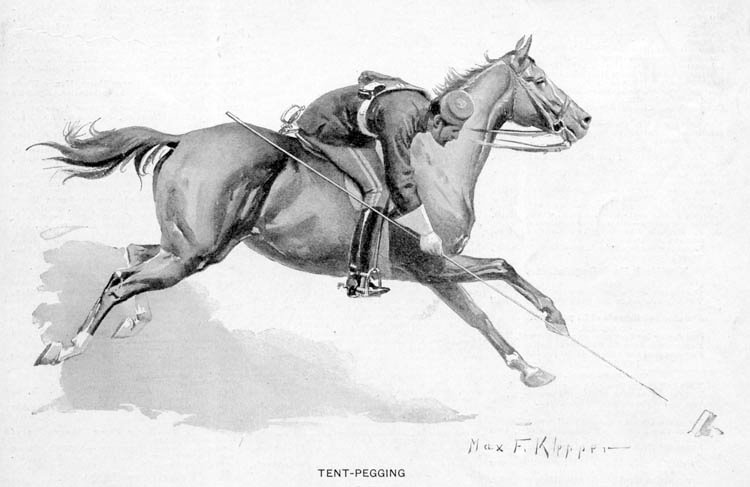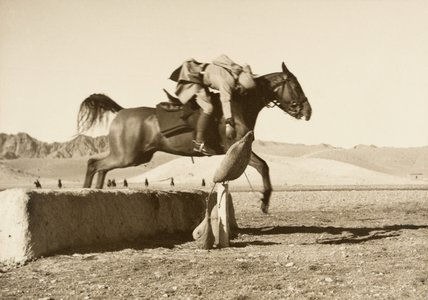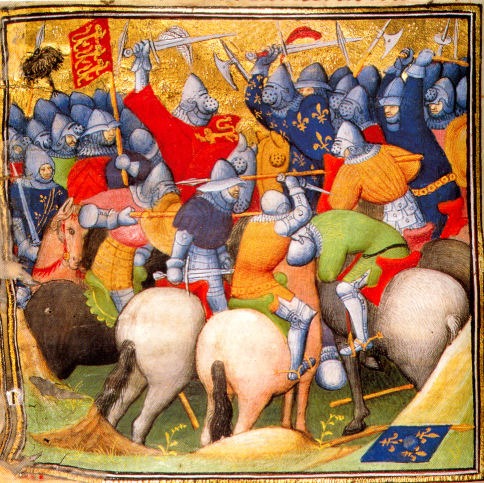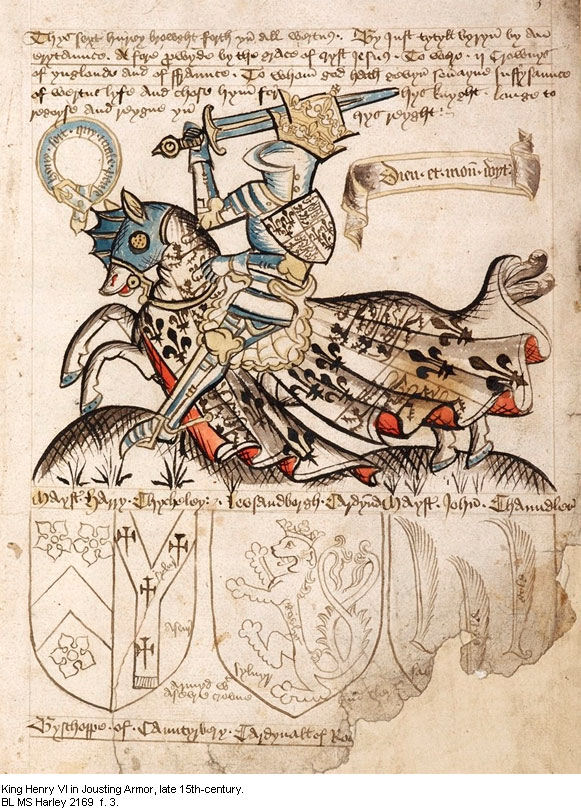The final item on the Green Spur checklist is:
Describe the mechanics required to keep your seat when striking from horseback.
And here we come back to that Independant Seat once more. It keeps cropping up because it is probably the most important component not just of mounted combat, but of all your riding endeavours. Riders at the famous haute école riding schools such as the Spanish Riding School and the Cadre Noir spend two years on the longe-line developing their seat before they are allowed to touch the reins.
With a balanced seat you can do almost anything, from airs above the ground such as the courbette performed by the Cadre Noir on the right, to stabbing targets over jumps like the tent-pegger below.
The secret to keeping your seat when delivering sword blows is the distribution of weight in your saddle. When we ride, we don't sit in the saddle -- we merely rest our seat bones there. Only 40% of your weight should be in your saddle's seat (or less, when in light seat, and none at all in two point positon). The remainder is divided evenly between the balls of your feet. An even better seat would have 10% of your weight in each seat-bone, and 10% in each of your inner thighs, spread evenly throughout the saddle.
With your hips directly above your heels, and your knees above your toes, and your ankles flexed so the heels are down, your lower body is now in perfect mechanical balance. From here you can use your shoulders and arms freely, delivering cuts in all directions, without disturbing your seat.
This image of a melee from the battle of Crécy illustrates leg position beautifully: with all the chaos around them, and the fact one combatant is about to stabbed in the back of the head, the riders never lose their leg position or base of support.
However, many illustrations also show riders with their legs pushed forward in long stirrups, with their seats braced against the high cantle, as in this picture of England's Henry VI.
According to Duarte, this appeared to be a matter of personal preference and regional custom. The braced seat, while useful when jousting or charging with a lance, provides much less balance and flexibility for delivering sword blows. The fact this position appears more often in highly stylized illustrations also makes me wonder artistic preference tended to exaggerate it.
I have found when teaching beginners that some people have a naturally balanced seat, while for others it takes much more work. The good news, however, is that with enough practice, everybody can develop an independant seat. If you don't have the opportunity to spend time in the saddle every day, don't despair: there are ways you can improve your seat with nary a horse in sight.
- Stand with your feet a horse-width apart on the bottom stair or a doorsill, with just the toes balls of your feet resting on the step. Bend your knees and find your balance. This is exactly the position your legs need to be in when riding. Practice it ever chance you get.
- Sit backwards on chairs, with your heels beneath your hips. If you have yoga blocks or phone books, put them under your toes so you can lower your heels.
- 'Ride' a large exercise ball or a barrel. Practice lengthening your inner thigh along the surface of the barrel and feel your weight distributed evenly from seat-bone to knee.
- Visualize. The brain is an amazing organ that can train your muscles without moving them. Even lying in bed and thinking about the feel of your body in the saddle will help your adopt a better position next time you get on a horse.
This concludes the series of posts that walk you through the Green Spur. To review the material you can search under the tags Horsemanship 1, Riding 1, and Green Spur. Posterous will disappear in a few weeks, so if you can't find them in the blog archives on academieduello.com, I have also begun archiving them on my own blog: http://jmlandels.stiffbunnies.com/category/cavaliere/
next: The Blue Spur Curriculum
Thank you!
Huge thanks to everyone who came out to spend a sunny Easter Sunday at the barn, spreading lime and seed and battling blackberries! We rescued about 6 paddocks worth of pasture from the evil briars (at considerable cost to our skins) and are now just waiting for the rain to come and get that grass growing again. Red Colt turns two in less than a month, and we'll celebrate by torching those nasty blackberry canes sometime later this month. Stay tuned for details!
Our lovely freshly harrowed ring!
Intro to Mounted Combat
There is still one space available in the Intro to Mounted Combat class coming up this Sunday April 7th. The next Intro isn't until June, so call 604 568 9907 if you want to get out and enjoy swinging swords from horseback before summer hits!
Jennifer Landels, Maestra di Scuderia
Academie Duello Cavaliere Program
Comment on this post on our Posterous Blog.




